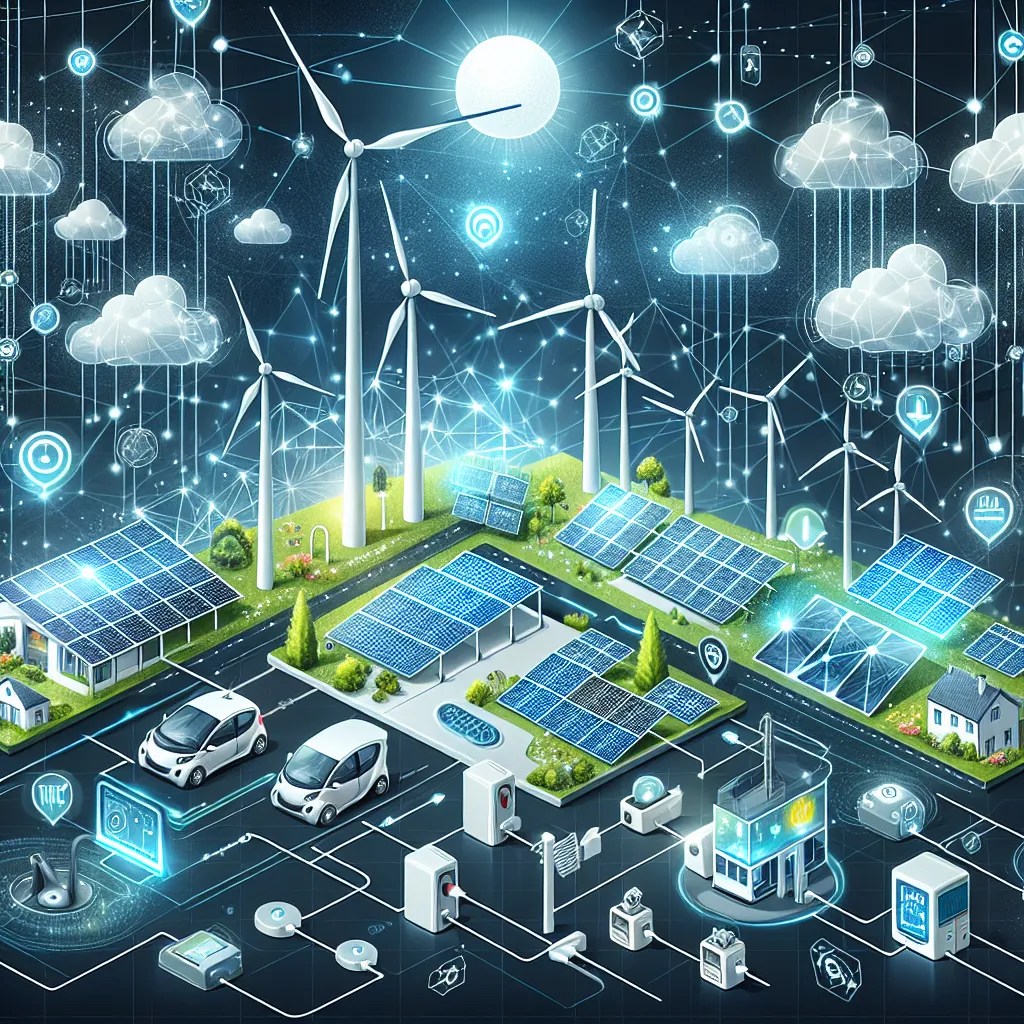Welcome to IELTS.NET, your trusted resource for IELTS preparation. Today, we’ll dive into an engaging IELTS Reading practice test focused on “The Future of Smart Grids in Sustainable Energy.” This topic is not only relevant for your exam but also crucial for understanding the evolving landscape of renewable energy and power distribution systems.
Nội dung bài viết
 Smart Grid Illustration
Smart Grid Illustration
IELTS Reading Practice Test: The Future of Smart Grids in Sustainable Energy
Let’s begin with our comprehensive IELTS Reading practice test. This test consists of three passages of increasing difficulty, mirroring the actual IELTS exam structure. We’ll explore various aspects of smart grids and their role in sustainable energy.
Passage 1 (Easy Text)
Smart Grids: The Backbone of Modern Energy Systems
The concept of smart grids has revolutionized the way we think about electricity distribution and consumption. Unlike traditional power grids, smart grids incorporate advanced digital technology to optimize energy flow and usage. These innovative systems utilize two-way communication between utility companies and consumers, enabling real-time monitoring and management of electricity consumption.
One of the key features of smart grids is their ability to integrate renewable energy sources seamlessly. As the world shifts towards sustainable energy production, smart grids play a crucial role in accommodating the intermittent nature of renewable sources like solar and wind power. By balancing supply and demand more effectively, smart grids reduce energy waste and improve overall efficiency.
Smart meters, an essential component of smart grids, provide detailed information about energy usage to both consumers and utility companies. This data empowers consumers to make informed decisions about their energy consumption, potentially leading to reduced bills and a smaller carbon footprint. For utility companies, smart meters offer insights that help in predicting demand patterns and managing the grid more efficiently.
The implementation of smart grids also enhances grid reliability and resilience. These systems can quickly detect and isolate power outages, facilitating faster restoration of service. Moreover, they can preemptively identify potential issues before they escalate into major problems, thereby reducing the frequency and duration of blackouts.
As we look to the future, smart grids are expected to play an increasingly important role in creating sustainable, efficient, and reliable energy systems worldwide. Their ability to adapt to changing energy landscapes makes them a cornerstone of modern urban planning and sustainable development strategies.
Questions 1-5
Do the following statements agree with the information given in the passage?
Write:
TRUE if the statement agrees with the information
FALSE if the statement contradicts the information
NOT GIVEN if there is no information on this
- Smart grids use one-way communication between utility companies and consumers.
- Renewable energy sources can be easily integrated into smart grid systems.
- Smart meters help consumers reduce their energy bills.
- Smart grids are more expensive to maintain than traditional power grids.
- The implementation of smart grids can help in faster restoration of power after outages.
Questions 6-10
Complete the sentences below.
Choose NO MORE THAN TWO WORDS from the passage for each answer.
- Smart grids incorporate advanced __ technology to optimize energy flow and usage.
- The __ nature of renewable energy sources like solar and wind power can be managed better with smart grids.
- Smart meters provide __ information about energy usage to consumers and utility companies.
- Smart grids can enhance grid __ and resilience.
- Smart grids are considered a __ of modern urban planning and sustainable development strategies.
Passage 2 (Medium Text)
The Role of Smart Grids in Sustainable Energy Transition
The global shift towards sustainable energy sources has brought about significant challenges in power distribution and management. Smart grids have emerged as a pivotal solution to these challenges, offering a more flexible and efficient approach to energy management. These intelligent systems are not merely an upgrade to existing infrastructure but represent a fundamental paradigm shift in how we generate, distribute, and consume electricity.
One of the primary advantages of smart grids is their ability to accommodate the variable nature of renewable energy sources. Solar and wind power, while clean and sustainable, are inherently intermittent. Traditional power grids struggle to balance these fluctuations, often leading to energy waste or shortages. Smart grids, however, employ advanced forecasting algorithms and real-time data analysis to predict and manage these variations effectively. This capability is crucial for increasing the share of renewable energy in the overall energy mix without compromising grid stability.
Smart grids also play a vital role in demand-side management. By providing consumers with detailed information about their energy usage patterns and real-time pricing, smart grids encourage more conscious and efficient energy consumption. This two-way flow of information enables consumers to adjust their usage based on grid conditions, potentially shifting non-essential consumption to off-peak hours. Such demand response mechanisms not only reduce strain on the grid during peak times but also help in optimizing the use of available renewable energy.
The integration of energy storage systems is another key aspect where smart grids excel. As battery technology advances, smart grids can effectively manage the charging and discharging of large-scale batteries, smoothing out supply fluctuations and storing excess renewable energy for later use. This capability is particularly important for microgrids – localized grids that can operate independently from the main grid – enhancing energy resilience in remote areas or during power outages.
Furthermore, smart grids are essential for the widespread adoption of electric vehicles (EVs). They can manage the additional load on the grid from EV charging, potentially using EVs as mobile energy storage units through vehicle-to-grid (V2G) technology. This bi-directional charging capability could transform EVs from mere consumers of electricity to active participants in grid stabilization.
As we progress towards a more sustainable future, the role of smart grids in facilitating this transition cannot be overstated. Their ability to integrate diverse energy sources, optimize distribution, and empower consumers positions them as a cornerstone of future energy systems. However, the full realization of smart grid potential requires significant investment in infrastructure, robust cybersecurity measures, and supportive policy frameworks.
Questions 11-15
Choose the correct letter, A, B, C, or D.
-
According to the passage, smart grids are:
A) A minor upgrade to existing power grids
B) A fundamental change in energy management
C) Only useful for renewable energy sources
D) Too complex for widespread implementation -
The main advantage of smart grids in managing renewable energy is their ability to:
A) Eliminate the need for traditional power sources
B) Store unlimited amounts of solar and wind energy
C) Predict and manage variations in energy production
D) Completely stabilize renewable energy output -
Demand-side management in smart grids:
A) Forces consumers to use less energy
B) Only benefits utility companies
C) Encourages more efficient energy consumption
D) Has no effect on grid stability -
The integration of energy storage systems in smart grids:
A) Is not yet possible with current technology
B) Only works for small-scale applications
C) Helps manage supply fluctuations and store excess energy
D) Eliminates the need for renewable energy sources -
The passage suggests that electric vehicles in smart grid systems:
A) Are a major problem for grid stability
B) Can only be charged during off-peak hours
C) May serve as mobile energy storage units
D) Will replace traditional power plants
Questions 16-20
Complete the summary below.
Choose NO MORE THAN TWO WORDS from the passage for each answer.
Smart grids represent a (16) __ in energy management, offering solutions to challenges posed by the transition to sustainable energy. They use advanced (17) __ and data analysis to manage the variability of renewable energy sources. Through (18) __, smart grids encourage efficient energy use by providing consumers with detailed information. The integration of (19) __ allows for better management of energy storage and supply fluctuations. Smart grids are also crucial for the adoption of electric vehicles, potentially using them for (20) __ through V2G technology.
Passage 3 (Hard Text)
The Future Landscape of Smart Grids: Challenges and Opportunities
As the global energy landscape continues to evolve, smart grids stand at the forefront of a technological revolution in power systems. These advanced networks, characterized by their ability to integrate information and communication technologies with power distribution infrastructure, promise to reshape the future of energy management. However, the path to widespread smart grid implementation is fraught with complex challenges that demand innovative solutions and collaborative efforts across multiple sectors.
One of the primary hurdles in smart grid development is the substantial investment required for infrastructure upgrades. The transition from traditional power grids to smart systems necessitates the deployment of advanced sensors, smart meters, and sophisticated control systems across vast geographical areas. This financial burden is often compounded by the need to retrofit existing infrastructure, a process that can be both costly and technically challenging. Policymakers and utility companies must grapple with the question of how to finance these upgrades while ensuring that the costs are not disproportionately passed on to consumers.
The cybersecurity implications of smart grids present another significant challenge. As power systems become increasingly digitized and interconnected, they also become more vulnerable to cyber attacks. The potential consequences of such attacks on critical energy infrastructure are severe, ranging from widespread power outages to the compromise of sensitive consumer data. Developing robust cybersecurity protocols that can protect against evolving threats while maintaining system efficiency is a complex task that requires ongoing attention and investment.
Interoperability among various smart grid components and systems is crucial for realizing the full potential of this technology. However, achieving seamless integration is complicated by the diversity of existing infrastructure, varying technical standards, and the rapid pace of technological advancement. Establishing universal standards and protocols that allow for effective communication between different smart grid elements, while also accommodating future innovations, remains a significant challenge.
The integration of distributed energy resources (DERs), such as rooftop solar panels and small-scale wind turbines, into smart grids presents both opportunities and challenges. While DERs can enhance grid resilience and reduce reliance on centralized power generation, they also introduce complexity in terms of power flow management and grid stability. Smart grids must evolve to effectively orchestrate these diverse energy sources, balancing supply and demand in real-time while maintaining power quality.
Data management and privacy concerns also loom large in the smart grid landscape. The vast amounts of data generated by smart meters and other grid sensors offer unprecedented insights into energy usage patterns, potentially leading to more efficient grid operation and personalized energy services. However, this data collection raises important questions about consumer privacy and data ownership. Striking the right balance between leveraging data for grid optimization and protecting individual privacy rights is a delicate challenge that requires careful consideration and robust regulatory frameworks.
Despite these challenges, the potential benefits of smart grids are immense. They offer the promise of increased energy efficiency, reduced carbon emissions, improved grid reliability, and greater integration of renewable energy sources. Moreover, smart grids can empower consumers to become active participants in the energy market, potentially leading to more competitive pricing and innovative energy services.
Looking ahead, the future of smart grids will likely be shaped by advancements in artificial intelligence and machine learning. These technologies could dramatically enhance the predictive capabilities of smart grids, enabling more sophisticated demand forecasting, fault detection, and self-healing mechanisms. The emergence of blockchain technology also holds promise for facilitating secure, decentralized energy transactions within smart grid networks.
As we navigate the complexities of transitioning to a more sustainable and resilient energy future, smart grids will undoubtedly play a pivotal role. Overcoming the challenges associated with their implementation will require sustained investment, technological innovation, and collaborative efforts across industry, government, and academia. The journey towards fully realized smart grid systems may be complex, but the potential rewards in terms of energy sustainability and efficiency make it a critical endeavor for our global future.
Questions 21-26
Complete the sentences below.
Choose NO MORE THAN TWO WORDS from the passage for each answer.
- The integration of __ with power distribution infrastructure characterizes smart grids.
- A major challenge in smart grid development is the need for substantial __ in infrastructure upgrades.
- The increasing digitization of power systems makes them more vulnerable to __.
- Achieving __ among various smart grid components is crucial but complicated by diverse existing infrastructure.
- The integration of __ into smart grids enhances grid resilience but also introduces complexity.
- Smart grids generate vast amounts of data, raising concerns about consumer __ and data ownership.
Questions 27-31
Do the following statements agree with the claims of the writer in the passage?
Write:
YES if the statement agrees with the claims of the writer
NO if the statement contradicts the claims of the writer
NOT GIVEN if it is impossible to say what the writer thinks about this
- The cost of upgrading to smart grid infrastructure will inevitably be passed on to consumers.
- Cybersecurity threats to smart grids can be completely eliminated with current technology.
- Smart grids will lead to more competitive energy pricing for consumers.
- Artificial intelligence will play a significant role in enhancing smart grid capabilities.
- The challenges of implementing smart grids outweigh their potential benefits.
Questions 32-35
Choose the correct letter, A, B, C, or D.
-
According to the passage, one of the main challenges in retrofitting existing infrastructure for smart grids is:
A) The lack of technical expertise
B) Resistance from utility companies
C) The cost and technical difficulty
D) Environmental regulations -
The passage suggests that the integration of distributed energy resources (DERs) into smart grids:
A) Is impossible with current technology
B) Offers only challenges and no benefits
C) Requires careful management of power flow
D) Will completely replace centralized power generation -
The author’s stance on the future of smart grids can best be described as:
A) Highly skeptical
B) Cautiously optimistic
C) Indifferent
D) Overwhelmingly negative -
Which of the following is NOT mentioned as a potential benefit of smart grids?
A) Increased energy efficiency
B) Reduced carbon emissions
C) Improved grid reliability
D) Elimination of all power outages
Answer Key and Explanations
Passage 1
-
FALSE – The passage states that smart grids use “two-way communication.”
-
TRUE – The passage mentions that smart grids can “integrate renewable energy sources seamlessly.”
-
TRUE – It states that smart meters provide information that can lead to “reduced bills.”
-
NOT GIVEN – The passage doesn’t compare maintenance costs of smart grids to traditional grids.
-
TRUE – The text mentions that smart grids can “facilitate faster restoration of service.”
-
digital
-
intermittent
-
detailed
-
reliability
-
cornerstone
Passage 2
-
B – The passage describes smart grids as representing a “fundamental paradigm shift.”
-
C – It states that smart grids “employ advanced forecasting algorithms and real-time data analysis to predict and manage these variations effectively.”
-
C – The passage mentions that smart grids “encourage more conscious and efficient energy consumption.”
-
C – It’s stated that smart grids can “effectively manage the charging and discharging of large-scale batteries, smoothing out supply fluctuations.”
-
C – The passage suggests that EVs could be used as “mobile energy storage units.”
-
paradigm shift
-
forecasting algorithms
-
demand-side management
-
energy storage systems
-
grid stabilization
Passage 3
-
information and communication technologies
-
investment
-
cyber attacks
-
interoperability
-
distributed energy resources
-
privacy
-
NOT GIVEN – The passage mentions this as a concern but doesn’t state it as inevitable.
-
NO – The passage suggests ongoing attention and investment are needed for cybersecurity.
-
YES – The text states that smart grids can lead to “more competitive pricing.”
-
YES – The passage mentions that AI could “dramatically enhance the predictive capabilities of smart grids.”
-
NO – While challenges are discussed, the passage ultimately emphasizes the “immense” potential benefits.
-
C – The passage mentions both the cost and technical challenges of retrofitting.
-
C – It states that DERs introduce complexity in “power flow management.”
-
B – The overall tone suggests cautious optimism, acknowledging challenges but emphasizing potential benefits.
-
D – While improved reliability is mentioned, complete elimination of outages is not stated as a benefit.
Conclusion
This IELTS Reading practice test on “The Future of Smart Grids in Sustainable Energy” covers a wide range of aspects related to smart grids, from their basic functions to complex challenges and future prospects. By engaging with this material, you’ve not only practiced your reading skills but also gained valuable insights into an important aspect of sustainable energy development.
Remember, success in IELTS Reading comes from regular practice and developing strategies to tackle different question types efficiently. Keep exploring various topics and question formats to enhance your skills further.
For more IELTS preparation resources and practice materials, don’t forget to check out our other articles on renewable energy job markets and the impact of renewable energy on reducing carbon footprints. These topics are closely related to smart grids and can provide additional context and vocabulary


